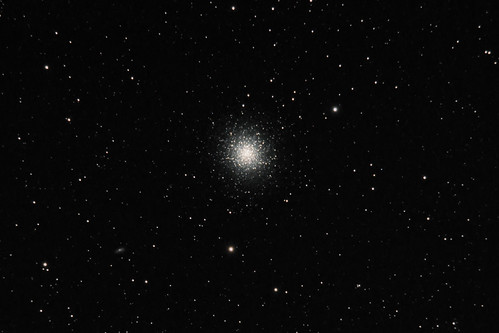14 -15 April 2020, 23:30 – 02:45
Conditions: Slight breeze, hazy bands of cloud receding low in the southeast.
Seeing: Poor
Transparency: Average
I was in the mood for something different after all those faint galaxies, so I started a bit later than usual with a session devoted (mostly) to globular clusters. All observations carried out at 133x with the 9mm Nagler. In the XT10 this eyepiece seems to hit the sweet spot for framing and resolving globulars; also, sticking to one magnification for the entire session makes it easier to compare one cluster to another.
M13, globular cluster, Hercules
What better place to start? (I returned to this cluster several times during the session as it rose higher in the sky.) Stunning as always, and for the first time I clearly saw the dark Y-shaped “propeller feature” adjacent to the core. Like the nearby galaxy NGC 6207, I suspect it’s one of those things that becomes fairly obvious after you’ve seen it once. No overall colour to the cluster that I could see – at least not on this occasion.
M92, globular cluster, Hercules
Smaller than M13, but an impressive globular in its own right. Well resolved. Oval shape. Slight blue tinge.
NGC 6229, globular cluster, Hercules
The “baby bear” of the three Hercules globulars. Small, condensed, quite bright. Grainy, but no stars resolved.
M104, Sombrero Galaxy, Virgo
A “stop-off” on the way to M68. Long, saucer-shaped galaxy with central bulge and bright stellar core. Dark lane clearly seen offset to the south.
M68, globular cluster, Hydra
Large, faint misty patch of light, all but washed out by its low altitude and atmospheric haze. With averted vision it seemed a little mottled, but that was all I could make out. A tough object – I lost it a couple of times and had trouble relocating it.
NGC 4565, Needle Galaxy, Coma Berenices
Very long and thin compared to M104, extending almost halfway across the field of view. Star-like nucleus embedded in slightly bulging core. Dark lane cutting across core; with averted vision it can be seen extending further out across the galaxy.
NGC 5634, globular cluster, Virgo
Small, round unresolved fuzzball, not very condensed. Faint star to west, bright one to east.
M5, globular cluster, Serpens Caput
A lovely, rich condensed cluster, rivalling M13. Well resolved most of the way to the core. (It’s such a stunning cluster I completely forgot to check for colour.) Stars appear “swept back” to the east. Particularly prominent star just southeast of the core. Further away, just out of the field to the southeast, lies a bright and closely paired double star (5 Serpentis).
M83, Southern Pinwheel Galaxy, Hydra
Took a while to track down, and when I did it was literally grazing the neighbour’s fence (culminating at less than 9 degrees above the horizon!). The galaxy itself was just visible as a condensed fuzzy core, with a distinctive line of 3 stars to the south and east. Averted vision revealed a very faint surrounding haze. A minor miracle that I’m able to see a galaxy this far south (I only searched for it on a whim because the haze had cleared and all the neighbours’ lights were off). That I was able to see it all illustrates that it must be a spectacular object when viewed from more southerly latitudes.
M12, globular cluster, Ophiuchus
Unusual, spidery cluster with a pear-shaped core and two long straight “arms” of stars forming a flattened “X” shape. Also a seemingly detached clump of stars to the west and a bright (foreground?) star southeast of the core, reminiscent of the one in M5. A straggly cluster, quite well resolved, with lots of intriguing detail.
M10, globular cluster, Ophiuchus
A more “conventional” globular than M12, appearing as a rich, condensed ball of stars. Most distinctive features are a wavy arm of stars to the north and an opposing one extending south (like the integral sign or the f-hole on a violin). Well resolved.
M56, globular cluster, Lyra
Small, condensed globular residing in a rich Milky Way field. Bright star to west. Distinctive triangular core. Resolved fairly well with averted vision.
M14, globular cluster, Ophiuchus
Large, grainy, condensed cluster. Very few stars resolved – not sure if this was due to haze, interstellar dust extinction, or tiredness creeping in.
M107, globular cluster, Ophiuchus
A relatively faint, condensed cluster, smaller than M14. Grainy with averted vision. Again, possible haze/dust/tiredness affecting the view.
IC 4665, open cluster, Ophiuchus
Loose, boxy cluster of bright, blue-white stars of similar magnitude. Too large to fully appreciate at 133x, but looked very good in the finderscope and in 7x50 binoculars.
As tempting as it was to wait around for Scorpius (another constellation typically lost to the midsummer continuous twilight) to clear the neighbour’s tree, I’d been outside for over three hours, so I called it a night.

